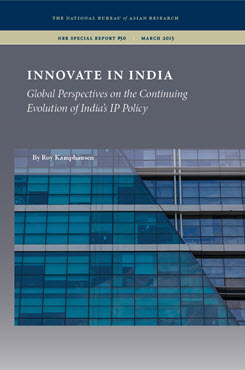NBR Special Report no. 50
Innovate in India
Global Perspectives on the Continuing Evolution of India's IP Policy
This report details India’s intellectual property (IP) and innovation policy environment and presents recommendations for how policymakers can enhance trading relationships through more robust IP protections.
EXECUTIVE SUMMARY
MAIN ARGUMENT
As Prime Minister Narendra Modi faces monumental challenges in returning India to high rates of economic growth—including poor infrastructure, stultifying labor laws, an excessive regulatory bureaucratic regime, and limited FDI—he has notably prioritized the “Make in India” campaign to build up India’s domestic manufacturing sector, engaging both indigenous and international firms in the process. But at a policy level, “Make in India” will depend on how quickly India can strengthen its IP regime as well. Stronger IP protection will reduce business uncertainty and increase investor confidence. Greater FDI will also lead to increased partnerships with foreign firms, and likely to substantially more tech transfers over time. Already, the benefits of greater IP protection are visible within parts of India: the states that protect IP best also have the highest rates of per capita GDP growth. Ultimately, India suffers more from lower IP protection—and would benefit more from a strengthened IP regime—than its foreign partners. Over the past year, the Modi administration has taken important first steps to address the country’s IP policy challenges. However, more needs to be done.
POLICY IMPLICATIONS
- India’s chief IP challenges are at the level of policy decision-making. Addressing those challenges, rather than focusing solely on strengthened enforcement regimes, is more likely to lead to successful outcomes.
- Collectively, India’s IP policy challenges erode the confidence of foreign firms to invest in India. Dismissing IP concerns as a “sectoral issue” underestimates the chilling effect on foreign investment in India’s economy, which could undermine the government’s “Make in India” objectives.
- Stronger international business community support for India’s IP reforms will contribute to improved “Make in India” results as more firms will invest and operate in India. As India further strengthens its IP legal regimes, capacity building in partnership with the international community will play an important role, such as in developing an IP court system or reducing regulatory backlogs.
- The U.S. and India need to bolster problem-solving mechanisms, on IP as well as on other issues, if broader aspirations for a deepened strategic relationship are to be realized.



